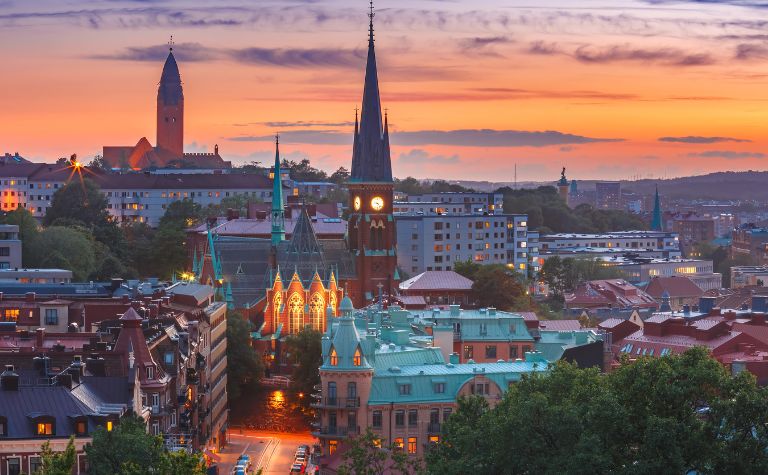Sweden, located in the northern part of Europe, is a nation known for its rich history, innovations, and striking natural beauty.
As a significant player in the European landscape, its size often sparks curiosity, especially when compared to its neighboring countries.
This article provides an in-depth look at Sweden’s size, both geographically and demographically, offering insights into its vastness in relation to other European nations.
Whether you’re a geography enthusiast or someone planning a visit, understanding Sweden’s scale can provide valuable context to its diverse culture and landscapes.
Also, see Why Did Skype and Spotify Start in Sweden? to learn more.

Geographical Size and Features
Sweden stretches across an impressive land area of approximately 450,295 square kilometers (or about 173,860 square miles), making it one of the larger countries in Europe.
This vast expanse is dotted with a variety of geographical features that contribute to its unique landscape.
Among the most notable are the Scandinavian Mountains, which run along its western border with Norway.
These rugged highlands offer not only breathtaking views but also form a natural boundary between the two nations.
Further south, the landscape transforms, offering vast plains and rolling hills that are ideal for agriculture.
Sweden is also home to thousands of lakes, with Lake Vänern and Lake Vättern being the largest.
These freshwater bodies provide important natural resources and have historically played a pivotal role in Sweden’s trade and transportation.
The nation’s east coast brushes against the Baltic Sea, boasting a rugged coastline dotted with archipelagos, particularly near cities like Stockholm.
This coastline, coupled with its vast forests – which cover over half of the country – ensures that Sweden maintains a strong bond with nature, balancing urbanization with preservation.
In summary, Sweden’s geographical size and features paint a picture of a nation that’s diverse in its landscapes, from towering mountains and expansive lakes to dense forests and a vast coastline.
This natural variety has shaped its history, culture, and even its socio-economic development.
Also, see Why Do Swede Takes Their Shows Off? to learn more.

Population Density and Urban Spread
With such a vast geographical area, one might expect Sweden to be densely populated throughout.
However, with a population of approximately 10 million inhabitants, its density stands at around 22 people per square kilometer.
This relatively low population density is attributed to the nation’s vast tracts of wilderness, forests, and uninhabited terrains, especially in the northern regions.
The majority of Swedes reside in urban areas, with cities becoming the hubs of activity, commerce, and culture.
Stockholm, the capital and largest city, alone houses over 2 million residents.
Other significant cities include Gothenburg and Malmö, both of which play crucial roles in the nation’s economy and cultural landscape.
It’s worth noting that while the northern parts of Sweden, such as Lapland, are sparsely populated, they remain crucial for their natural resources and as a testament to Sweden’s commitment to preserving natural habitats and indigenous cultures.
The distribution of Sweden’s population highlights a trend seen in many modern nations: a concentration of people in urban centers, with vast, less populated areas covering the majority of the country.
This urban spread has implications for infrastructure, economy, and cultural dynamics, with cities being the epicenters of growth and innovation.

Comparison with Other European Countries
In terms of land area, Sweden ranks as the third-largest country in the European Union, surpassed only by France and Spain.
However, when juxtaposed with its immediate neighbors, the contrast is even more evident.
Norway, while similar in geographical size, has a rugged terrain and a slightly smaller population. Finland, to the east, shares similar northern expanses but is notably smaller in both land area and population.
Denmark, on the other hand, is markedly smaller than Sweden.
Yet, its strategic location at the crossroads of the Baltic and North Seas has historically made it a significant maritime and trade power in the region.
When evaluating population density, Sweden stands out as having one of the lower densities among European nations, a consequence of its vast landscapes and larger uninhabited regions.
Countries like the Netherlands or Belgium, although much smaller geographically, have significantly higher population densities due to their compactness and urban-centric development.
In summary, Sweden’s sheer size, both in terms of land and low population density, sets it apart in the European context.
It combines vast natural landscapes with urbanized areas in a balance that’s unique among its continental peers.
This balance has shaped, and continues to influence, Sweden’s socioeconomic dynamics, policies, and its place in European geopolitics.
Conclusion
Sweden, with its vast landscapes and urban hubs, presents a unique blend of natural beauty and modern civilization in Europe.
Its size, both geographically and in terms of population density, distinguishes it from its neighbors and other European countries.
While its vastness offers boundless natural resources and habitats, its cities stand as testaments to Sweden’s socio-economic growth and cultural richness.
Understanding Sweden’s scale and its comparison with other nations provides valuable insight into its role, challenges, and contributions on the European stage.
Whether viewed through the lens of geography, history, or contemporary dynamics, Sweden’s size undoubtedly plays a pivotal role in its national identity and global interactions.
